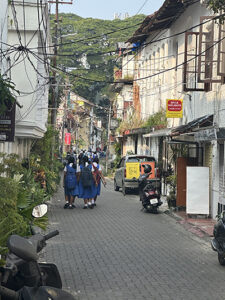This post originally appeared on Murder Is Everywhere.
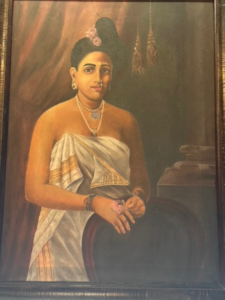
It feels like only yesterday that I was driving out of Kumarakom Village, in the Kottayam district near Lake Vembanad. That’s how much of lasting impact the gorgeous, green state of Kerala in South India has, even on my fifth visit.
From Kumarakom, it was 53 kilometers north to Kochi, with its historic port district still called Fort Cochin. Originally, this port town was part of the kingdom of Kochi, but in 1503, the territory was gifted by Kochi’s Rajah to the Portuguese who’d provided military support in war with a neighboring ruler. The Portuguese lost Kochi to Dutch colonizers in 1663, and then in 1814, the Dutch decided to swap the region with the British for a larger prize: Malaya.
Our driver knew the freeway was packed with traffic that Saturday, so he took us on scenic byways through little villages, where we saw people shopping at stands like this one. I had tasted a few varieties of bananas while staying at Kumarakom Lake Resort, but passing by these fruit vendors I heard that there are close to 100 varieties growing in Kerala. The banana is the state’s favorite fruit, and as I researched Kerala bananas later, I learned that unfortunately 25 to 40 percent of the crop is lost each year due to insufficient storage. It reminds me of what I’ve heard about the high food waste per household in the United States. But oh, how much I’d rather eat the tiny sweet bananas of Kerala, which can be sautéed, boiled, and also turned into snacking chips.
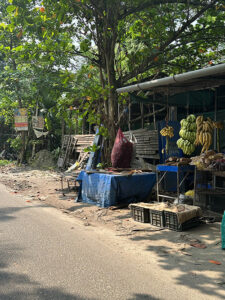
It was a pleasant hour-and-a-half journey to Fort Cochin, a district that seemed more densely packed with tourists than I remembered from my previous visits. Late October was still monsoon weather, meaning a torrential downpour of at least 90 minutes around 6 pm, but there were umbrellas in the lobby at Forte Kochi, our small hotel on Princess Street. And yes, there were plenty of bananas every day at the breakfast buffet.
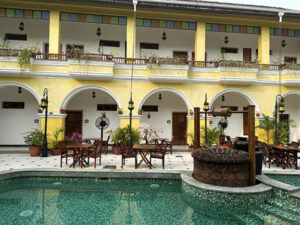
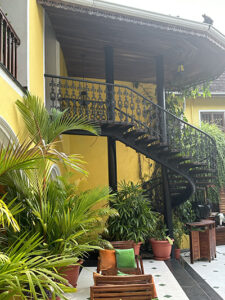
This particular hotel was originally a grand 19th century house built by the Dutch that later became the home of a prominent Jewish merchant family. This family added a mikvah in the courtyard. Colors are bright, from the stucco to the tiled stairs, and the spiral ironwork stairs are typical for Fort Cochin.
The ritual bath is still preserved, albeit with a guarding chain to keep guests from wandering down the steps into very murky water.
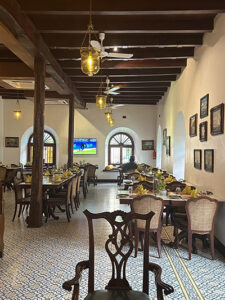
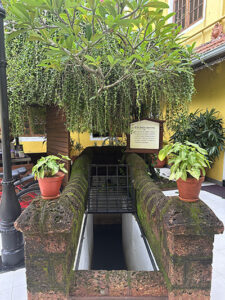
At present, the hotel is owned by a Kerala-based hotelier with a Christian name—Paul John. That name and the multicultural staff we met everywhere in Kochi reflect the diversity of many cultures living together peacefully for centuries–from the Dravidian people who had been the first known occupiers of the land that later hosted both Muslim and Hindu kingdoms, as well as the Protestant and Catholic Christian Indians whose ancestors had settled here before Christianity had arrived in Europe. Then there were Middle Eastern immigrants including Muslim traders and Jewish sailors. A beautifully preserved synagogue still stands in Fort Cochin, although the Jewish population in all of Kerala is said to have reduced to just fifteen people.
To deeply engage with Kerala’s history means reading. I was delighted to see that right around the corner from the hotel was an independent bookstore in a historic house called Idiom. Inside Idiom’s cozy ground floor, I found many shelves of old and new books, with a special focus on history and culture of the area.
I’d been trying to remember the title of a highly-praised nonfiction book about Travancore’s famous maharanis, and Thushara, the co-owner, helped me find it: Manu Pillai’s book, The Ivory Throne: Chronicles of Travancore. I also couldn’t resist Aliyah, The Last Jew in the Village, a historical novel originally written in Malayalam by Sethu.
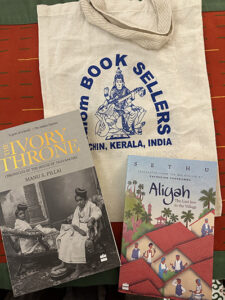
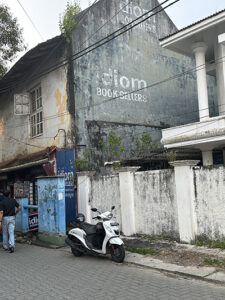
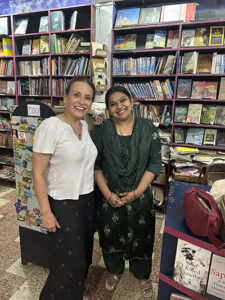
Book-buying was followed by an afternoon pause to let the rain arrive, have its way with the town, and then subside. It was time to walk to dinner at a delightful restaurant, Fusion Bay. But conversation inside the restaurant was overwhelmed for twenty minutes by the loud sound of fireworks, traffic and beating drums. We hurried outside to join the throngs of people watching a parade that included everyone from men on motorcycles to nuns. An image of Jesus was carried aloft, and we suddenly realized it was All Saints Day, and this was likely a church parade delayed a bit by the monsoon rain.
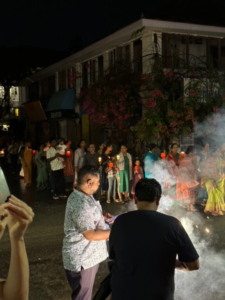
The next morning, we went for a pre-breakfast walking tour with an excellent local guide. He explained the colorful paintings on some of the old house walls were part of one of Kochi’s past Biennale expositions of international art. It’s not clear if the Biennale will continue, due to financial constraints, but the art will endure. We also walked to the area where local men still catch fish using gigantic fishing nets, and through old parks and residential district with more eye-candy houses.
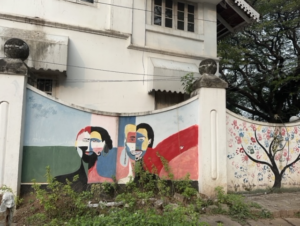
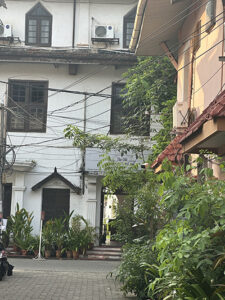
We left Fort Cochin that afternoon to visit to the nearby city of Ernakalum in order to lose a few hours at the Kerala Folklore Museum. Started by the late George Thaliath and continued by his wife and children, this museum holds thousands of objects, large and small, ranging from temple statuary to paintings and poison-testing dishes used in old royal courts. The vast scope household and temple artifacts and art of various periods made the immensity of Kerala’s history almost overpowering. Perhaps because my head is stuck in the 1920s, I zoomed in on a painting of a lovely young aristocratic woman in painting from that time. The museum also has a lovely gift shop like I’ve never seen that sells antique and modern crafts, and artisan-made textiles and jewelry.
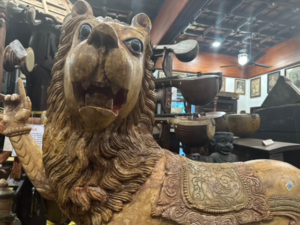
My time for Fort Cochin was just two nights, but Air India complications with a five-times-delayed flight from the Kochi Airport meant that we almost didn’t leave. I had the same experience with a much-delayed Air India flight from Cochin twenty-six years ago, and that delay lasted six days! It’s one thing to hole up in a nice hotel room when it rains, but nobody wants to be held up for more than 18 hours when other airlines are running flights to the same place. Therefore, after a few hours, we gave up on Air India and booked on Indigo for a 2 am flight to Mumbai. As frustrating as the situation was, there was something adventurous about flying in the middle of the night from a mostly deserted airport terminal. And then, before the sun had risen, we had reached Mumbai.
